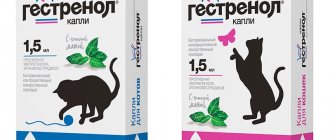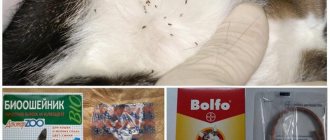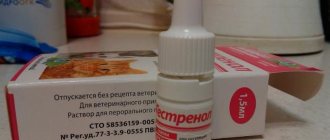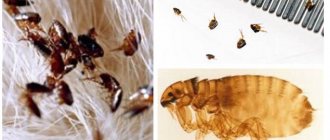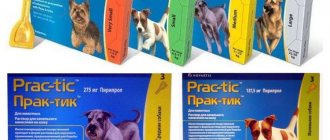Frontline - flea and tick medications
Frontline is a brand of veterinary drugs intended for the treatment and prevention of ectoparasites. The manufacturer and developer of these drugs is the French company Merial. The main principle of the company is the development and implementation of ready-made innovative solutions in the field of veterinary medicine.
Frontline drug formulas were developed by French scientists (Merial)
Employees of the development company call their products new generation drugs. Indeed, Frontline quickly found its place in the global market. Frontline contains a unique formula based on fipronil (this is a very effective component that is used not only in veterinary medicine, but also in medicine, as well as in crop production). Merial produces several types of products:
- Frontline Spray (an effective and convenient spray against ectoparasites);
- Frontline Spot On (classic drops for application to the withers);
- Frontline Tri-Act (universal drug for cats and dogs against ticks, mosquitoes and fleas);
- Frontline Combo (a non-systemic drug for external use that does not penetrate the animal’s circulatory system);
- Frontline Nexgard (flea and tick remedy for dogs in the form of chewing gum and with the active ingredient - afoxolaner).
Composition and release form of the drug Frontline
To combat skin parasites of cats, the French corporation Merial SAS created the drug Frontline. The company conducts serious research and has a strong reputation in the market for manufacturers of veterinary drugs.
The drug is available in three dosage forms:
- drops in polyethylene pipette bottles with a volume of 0.5 to 4.02 ml;
- spray in bottles with a sprayer of 100, 250 and 500 ml;
- Chewable tablets (for dogs only)
Table: dosage forms for cats
| Name | Dosage form | Volume, ml | Included | |
| active substance | Excipients | |||
| Frontline Spot On | drops on the withers |
| fipronil |
|
| Frontline Combo | drops on the withers |
|
|
|
| Frontline Spray | spray |
| fipronil |
|
Photo gallery: release forms
Active ingredients of the veterinary drug Frontline:
- Fipronil has a detrimental effect on the central nervous system of parasites, disrupting the movement of nerve impulses. Causes paralysis and subsequent death of insects. Fipronil does not have a systemic effect on the body of a pet, destroying only pests.
- S-methoprene (as part of Frontline Combo) is an analogue of the hormone-regulator of insect growth, causes developmental anomalies at the egg and larval stages, prevents the appearance of adult individuals on animals and in places where they are kept.
Additionally, Frontline contains excipients:
- in the spray - isopropanol, copolyvidone, purified water, polysorbate;
- in drops on the withers - butylated hydroxyanisole, butylhydrotoluene, diethylene glycol, polyvidone, polysorbate.
The content of the active substance in any form ensures effective destruction of parasites.
Frontline for cats
Several types of Frontline have been developed to protect and treat cats from ectoparasites.
If you have a cat, Spot On drops, Combo or Frontline spray are suitable for you. They are all based on fipronil, but there are significant differences in the form of the drug, methods of use and principle of action.
Classic drops Spot On
Frontline Spot On is a fipronil-based drop for spot application. The drug is active against the following types of parasites:
- fleas;
- lice;
- lice eaters;
- ixodid ticks;
- Cheylitella and Otodectos.
Spot-On is one of the most convenient drugs for getting rid of ectoparasites
The solution is packaged in small polymer pipettes. Their volumes may vary, but 0.5 ml packaging is suitable for cats. These pipettes are disposable; the tip of the pipette must be broken off before use. They are connected together in 3 pieces into one flat blister. The blister contains information about the drug:
- manufacturer's name;
- trademark;
- volume of pipettes;
- composition of the drug;
- indications for use;
- release series number;
- production date and expiration date.
To remove the pipette from the blister, you will have to cut it with scissors or separate it from the cardboard base with your hands.
One side of the pipette is transparent, the other is matte paper (with an inscription)
You need to store Frontline according to the general rules:
- in a dark, dry place;
- away from fire and direct sunlight;
- in a place inaccessible to children and animals;
- separately from food and animal feed;
- in manufacturer's packaging;
- at storage temperatures from 0 to 25 degrees Celsius;
- within 3 years.
If the drug was not stored according to the rules, the expiration date has expired or the drops have changed their color (appearance), then they should be thrown away. Since the components of the drug are toxic, it is important to prevent the animal from coming into contact with the product (the cat can climb into the trash and play with the pipette).
Drops Combo
Combo is drops against ectoparasites with double effect
Drops Combo (Frontline Combo) is one of the variants of Frontline, which contains two active ingredients:
- fipronil (9.8%);
- S-methoprene (8.8%).
It is a clear liquid with a specific odor, but no color. They are packaged in the same way as Spot On, the version for cats is 0.5 ml. Combo drops are active against adults and larvae:
- lice and fleas;
- lice eaters;
- ticks (ixodid and cheylitilla).
Fipronil destroys ectoparasites, causing paralysis. And the second, S-methoprene, disrupts the development of eggs and larvae, destroying the chitinous shell. This leads to the death of immature insects.
The drug is not absorbed into the animal’s blood, but is evenly distributed in the sebaceous glands (during the day). This explains the duration of exposure to ectoparasites in places of their usual accumulation. The drug should be stored in the same way as Spot On drops.
Spray Frontline
Frontline spray is more expensive than drops, but cat owners find it the most convenient to use
The spray from the French manufacturer (Frontline Spray) is a new generation product in a convenient form. The active ingredient of the antiparasitic agent is fipronil (2.5 mg). This spray is available in several volumes, but a 100 ml spray is suitable for protecting and treating cats. One package for a cat of average weight (5 kg) is enough for 13–20 months. The 100-milliliter matte white bottle is equipped with a sprayer. These bottles are sold without a box. On the jar itself there is a blue label with branded inscriptions:
- manufacturer;
- date and series of release, as well as expiration date;
- indications for use;
- storage conditions;
- volume and content of the active substance.
Folded instructions for use are attached to the bottle. It can be used repeatedly without removing it from the wall of the bottle. This is very convenient for storage.
I bought a 100 ml spray. The spray bottle is closed with a protective cap, instructions in the form of a book are glued to the can. By the way, this fact is very convenient, since separate inserts can get lost, but here it is always with the bottle.
Katushka, forum user
https://otzovik.com/review_3698625.html
To use the instruction booklet repeatedly, you do not need to completely tear it away from the bottle.
Frontline spray is used in the following cases:
- prevention of infection by fleas (Ctenocephalides felis) and ticks (Rhipicephalus, Ixodes);
- treatment of allergic dermatitis (AD) caused by fleas;
- prevention and treatment of cats from lice-eaters.
Are Frontline drugs safe?
- If the doses and rules of use are followed according to the instructions, the drug Frontline can rarely cause a negative reaction in the cat’s body, except in cases of individual intolerance to the components of the product in animals.
- However, when using the spray, the animal may experience short-term shortness of breath due to the large amount of liquid entering the animal's lungs.
- A double dose of the product, which the pet owner can use to enhance effectiveness, can harm the cat. The active component fipronil, in overdose, can cause tremors, convulsions and ataxia.
- If a kitten is treated with a single dose, there is a risk of developing intoxication.
- To prevent the drug from getting inside, it is recommended to put a protective collar on the animal, at least for a few hours.
Advantages and disadvantages of each product
It is not for nothing that the developer has provided 3 forms of the drug Frontline for cats. The fact is that each form has its own advantages and disadvantages. The veterinarian will prescribe exactly the form of the drug that is suitable for your cat. Some owners choose drops or spray on their own.
Choosing a flea and tick remedy is a very important point in protecting your cat, especially when it comes to the warm season. When my pets need a drug for prevention, I choose the drug myself (an important point here is the price of the drug). But if infection has already occurred, it is still better to contact a veterinarian. Sometimes I just call our regular veterinarian and ask for advice. Veterinarians know better than others about various new products and trends in this area. In addition, the veterinarian directly receives feedback from cat owners who have encountered the pros and cons of the medications.
You need to buy not the product that “turned up” in the veterinary pharmacy, but the one that is suitable in a particular case
Comparison table: pros and cons of different Frontline drugs
| Name | pros | Minuses |
| Drops Spot It | convenient application (does not get your hands dirty), low price, sold in many pharmacies, effective against ear mites | pipettes contain a small volume of solution that can spill (application of a smaller volume may negatively affect the effectiveness) |
| Drops Combo | convenient application, multifunctional (destroys both adult parasites and larvae) | small pipettes, presence of a specific odor |
| Spray | economical (enough for a whole year with regular use), the ability to bathe and walk the cat, effectiveness (distributed throughout the body) | high price, likelihood of human contact with the solution and allergies to alcohol-containing substances, the cat may be scared of splashes |
Indications for use
Frontline drops for cats are prescribed to eliminate insects that parasitize the skin of pets:
- Fleas.
- Ticks.
- Lice.
- Vlaseaters.
The drug is also prescribed for the progression of ear scabies. Spot He drops are instilled into each ear, having previously cleaned the auricles of dirt.
Instructions for use
Each form of the drug Frontline is supplied with detailed instructions. But the pharmacy will not always let you familiarize yourself with it before purchasing, so you can study all the intricacies of this product in advance. In addition, the seller at the pharmacy may give inaccurate information (for example, in order to sell another drug).
The pharmacist told me that drops on the withers and Frontline spray provide only 50% protection against ticks. Previously, yes, they were very effective, but now ticks have already adapted to them.
Viktorella, forum visitor
https://www.mydog.su/forum/frontlain-uzhe-ne-spasaet-ot-kleshchei
Classic drops Spot On
Before using drops, read the instructions for use
Before using Spot He drops, you need to calculate the dosage. According to the instructions, one 0.5 ml pipette is enough to treat a cat. For convenience, you can use the following diagram:
- Break off the tip of the pipette.
- Use your hands to spread the fur in the withers area (above the shoulder blades).
- Press the pipette and squeeze the entire solution into one place.
The liquid will distribute itself over the animal’s skin (this will take approximately 24 hours). If we are talking about the treatment of ear scabies, then the solution should be dripped directly into the pet’s ears (4-6 drops in each ear). To ensure that the solution is evenly distributed, the auricle can be carefully folded in half and lightly massaged. The remaining solution can be applied to the withers. The next time you use it (in about a month), you will need to use a new pipette.
If you plan to constantly (monthly) use drops for prevention, then it is more advisable to buy packages of 3 pipettes (it’s cheaper).
Video: how to apply Spot on drops
Drops Combo
According to the instructions, Combo drops should be applied to one or several points. Important: the protective effect of Combo against ticks lasts for 3 weeks. If you need to prevent infection by ticks, then the frequency of treatment can be reduced to once every 3 weeks (consult your veterinarian). However, it is recommended to carry out treatment no more than once a month. This period is reduced to 3 weeks if the cat is bathed frequently (for example, 2 times a month). Although it is not recommended to bathe the cat immediately after application (48 hours). It is also not recommended to use other insectoacaricidal agents together with Combo.
The manufacturer assures that if all recommendations are followed, the drug will not have any negative effect on the body. But cat owners sometimes experience a slight deterioration in their cat’s well-being. It is not recommended to treat weakened cats (for example, after illness).
If the drops get into the animal's eyes, there may be slight irritation, which will go away without any intervention. An allergy to the drug can occur if the animal has an individual intolerance to the components of the drug. In both cases, if unpleasant symptoms appear, the treatment should be stopped and the solution should be washed off the cat with running warm water. You can give your pet antihistamines. You can call the clinic and find out which allergy medicine is right for your pet. Usually they give Suprastin or Tavegil.
When working with Frontline, you must follow the safety and personal hygiene rules:
- while working with drops, do not drink, smoke, or eat;
- You can use rubber gloves to protect your hands, and a medical mask or respirator to protect your face;
- If the product gets on your skin, it should be washed off with running water;
- if drops get into your eyes or mouth, you should immediately rinse them and then consult a doctor;
- After finishing work, hands should be washed with soap and the used pipette should be disposed of.
Video: applying Frontline Combo drops
Spray Frontline
Using a spray may seem unusual because the process will be different from using drops. According to the instructions, you need to follow several rules:
- Spray the product at a distance of 10–20 cm (for better distribution).
- You need to spray the solution in the direction of hair growth so that all the hair gets wet (right up to the skin).
- Long-haired cats can be combed when spraying so that there are no dry areas left.
- To treat the face, apply the spray to your hand and then gently rub the liquid into the cat’s fur.
- Rub the solution into the fur on the face until it dries completely.
- Do not apply the solution with your hands or spray it into your cat's eyes.
- Do not use towels when spraying a cat.
Spray dosage: 6–12 presses of the spray button per 1 kg of cat’s weight. That is, to treat a cat weighing 3 kg you need to make at least 18 “sprays”. The spray will be active:
- against ticks - up to 5 weeks;
- against fleas - up to 3 months;
- against lice eaters - up to 42 days.
However, despite such different periods of time, it is recommended to carry out repeated treatment no earlier than 4 weeks after the previous one.
The spray must be applied with extreme care; it should not come into contact with the eyes or mucous membranes.
The spray can cause eye irritation not only in the cat, but also in the person who sprays it, so following safety rules in this case is especially important - use a mask, goggles and gloves. This spray should not be used by cats or people with hypersensitivity to the components of the drug. The fact is that the excipient in the spray is alcohol. There are also other restrictions mentioned by the manufacturer:
- Do not allow product to come into contact with exposed skin.
- If the spray gets on your skin, eyes or mouth, the solution should be washed off immediately.
- Even if you worked with gloves, wash your hands thoroughly with soap after handling the product.
- Children should not be allowed to play with a treated cat.
- Do not touch the cat until it is completely dry.
- It is not recommended to drink, eat or smoke while working with the spray.
- Kittens under 2 days old cannot be treated with the spray.
It is best to treat your cat in the evening (shortly before bed).
In our family, all relatives on my father’s side (including me) suffer from the most ridiculous allergy - a reaction to alcohol-containing liquids. If I have a sore throat, then I can’t use any “sprays” in my throat, only lozenges and gargles. We also shouldn’t make compresses or get carried away with perfume. All my fragrances are oil perfumes brought from the Emirates and Turkey. Of course, sprays for animals are also contraindicated for me. We cannot help but take this into account, because when working with such a product, we not only smell the alcohol, but also inhale its small drops.
Avoid using Frontline spray if you are allergic to alcohol
By the way, the instructions say that this spray is generally prohibited from being used by weakened animals, but then, a year ago, we did not read this, completely trusting the consultant. And in general, everything went without complications, the fleas died, and the cat-cat recovered.
OlinaLina, forum user
https://irecommend.ru/content/sprei-frontlain-ot-blokh-vshei-kleshchei-i-dazhe-komarov-opyt-primeneniya-na-kotenke-i-vzros
If your cat licks itself immediately after applying the solution, it may begin to salivate more, but this is only due to the chemical composition of the spray. Sometimes after using Frontline spray there may be unpleasant reactions:
- skin redness;
- itching at the application site;
- formation of bald spots;
- depression or increased nervousness (very rare);
- difficulty breathing or shortness of breath;
- nausea, vomiting.
The cat owner should remember that using a spray cannot guarantee a 100% result. In some cases, several parasites may survive, leading to their recolonization on the animal's body.
Video: how to apply Frontline spray
Can it be used in pregnant cats and kittens?
Frontline can be used to protect and treat pregnant, lactating cats and kittens (at least 2 days old). If we are talking about a nursing cat with kittens, then there is a small nuance - immediately after applying the drug, the kittens must be isolated from their mother (at least until the solution dries). There is no need to treat the nipples; the area around them should be moistened carefully (if we are talking about a spray). By the way, in such cases it is most convenient to use drops (the kittens will definitely not reach their mother’s withers). And if parasites (for example, fleas) appear in very young kittens, then a spray will do. Usually the entire procedure proceeds without consequences. The developers assure that if the recommendations are followed, the kittens and their mother will not have any side effects.
There is no need to go to the vet. Firstly, the action of the frontline is quite long, frequent treatments are generally useless, and secondly, the mother is still weakened after childbirth, she does not need unnecessary stress. In addition, there is a high risk of contracting an infection in the clinic, and this is very dangerous for kittens.
Which, forum user
https://forum.kotodom.ru/topic10390.html
Pregnant cats are treated in the same way as others - according to general rules.
Frontline can be used to protect and treat even small kittens
Interaction with other drugs
The developer warns that Frontline should not be used simultaneously with other insectoacaricidal drugs. But sometimes there are situations when one flea and tick medication does not work properly. A few days later, the cat’s owners try to use another remedy, and after that they turn to the veterinarian with the question “whether the cat will be poisoned.” Most protective drugs are designed so that the correct dosage cannot cause poisoning, so veterinarians allow the urgent replacement of one drug with another.
Frontline is not recommended for weakened animals, so its interaction with antibiotics and other strong drugs is excluded. If you think that your cat should be treated with Frontline, but at the same time she is being treated with some medications, then you can always contact a veterinarian. After all, there are exceptions to any rule.
My neighbors’ cat picked up ticks (the owners’ two-week vacation spent at the dacha had an effect). On the advice of friends, neighbors bought Frontline, which can be instilled into the ears. The head of the family suspected that the first application did not bring the desired result, so at the family council it was decided to repeat the instillation. After the second time, brown dirt appeared in the cat’s ears. The cat's owner's first thought was that the drops were fake. Of course, after such an event, the couple decided to take the poor thing to the vet. It turned out that the tick died after the first instillation, and the dirt in the ears was the result of otitis media. The veterinarian prescribed ear drops and vitamins, and they had to be taken on the same day, although not even a day had passed since the last use of Frontline.
Sometimes Frontline is combined with symptomatic drugs
Contraindications and side effects
Frontline is extremely toxic to rabbits. It is not allowed to use the product on kittens under 8 weeks of age and babies weighing less than 1 kg. The drug should not be used for pets who are weakened after serious illnesses, or if there are lesions on the cat’s skin.
The use of Frontline is not recommended for:
- individual intolerance to the components of the product;
- hypersensitivity to the components of the drug;
- allergic reactions.
Side effects from using Frontline medicines are rare. The animal's skin in the area where the drops are applied may temporarily become discolored or red, hair may fall out, or itching may occur. Allergic reactions can be eliminated by bathing the cat with shampoo and giving antihistamines.
How to distinguish real drugs from fakes
Despite the fact that my friend insisted that I should not use Frontline (there are many fakes), this brand firmly took 1st place among my favorites. I admit that Frontline products may be counterfeited, but I only buy drugs in large chain stores.
Lesarina, forum user
https://irecommend.ru/content/dorogo-i-effektivno-4
On the forums you can find many messages about the possible sale of Frontline counterfeits. Most doubts are based on the effect after using this remedy. However, real Frontline can also cause allergies; it all comes down to the cat’s sensitivity to various drugs.
Our cat developed a terrible allergy using the Frontline spray (the price is appropriate). Members of the forum warned that many fakes have appeared, and they are sold at high prices.
AllaZZZ, regular forum user
The real Frontline can be either French or Russian made, this fact can be confusing. In order not to “run into” a fake, you need to follow some rules:
- Never buy medications from someone else.
- Before purchasing, carefully study the packaging (it must indicate the production series and information about the manufacturer).
- If you have any doubts, you can ask the pharmacy for documents for the product (for example, a certificate).
Types of drugs and principle of action
The manufacturer produces the following types of Frontline drugs:
- Combo for dogs.
- Combo for ferrets and cats.
- Spot-on.
- Spray.
- Tri-ACT.
The list of active ingredients and their concentration in the preparations is shown in the table:
| Name | Concentration of active substances, % | ||
| Fipronil | S-methoprene | Permethrin | |
| Combo for dogs | 10 | 9 | |
| Combo for cats and ferrets | 10 | 12 | |
| Spot he | 10 | ||
| Spray | 0,25 | ||
| Tri-ACT | 6,76 | 50,48 | |
Fipronil and Permethrin interrupt the transmission of nerve signals to the muscles of arthropods, immobilizing them. Methoprene is structurally reminiscent of an arthropod hormone that is involved in the synthesis of chitin. In immature forms, the maturation process stops. The larval stages may not survive to the age where they can reproduce.
Frontline components do not enter the bloodstream, accumulate in the sebaceous glands, hair follicles, epidermis, hairs and provide long-term protection against parasites.
Frontline combo
The working fluid is poured into pipettes with a volume of 0.5; 0.67; 1.34; 2.68; 4.02 cm3.
Cost in September 2021 - 605 rub.
Frontline combo destroys lice eaters, fleas, ixodid and sarcoptic ticks, and mosquitoes. The treatment destroys ticks within 48 hours and other insects within 24 hours.
The tip of the Frontline combo pipette is broken off and squeezed onto clean, intact skin in places that are inaccessible for licking. The drug protects against attacks by ixodid ticks for 4 weeks. The repellent time against fleas and lice for cats and ferrets is 42 days, for dogs - 12 weeks. The drug is used as needed, at intervals of at least three weeks.
Dosage the insectoacaricide according to the scheme:
| Live weight, kg | Pipette volume, ml |
| Dogs | |
| >2<10 | 0,67 |
| >10<20 | 1,34 |
| >20<40 | 2,68 |
| >40 | 4,02 |
| Cats, ferrets | 0,5 |
Frontline is not prescribed to puppies up to 2 kg, kittens up to 8 weeks and weighing up to 1 kg, ferrets up to 6 months. The drug is prescribed to lactating animals under the supervision of a veterinarian. The female is isolated from the cubs for half an hour or more until the applied insectoacaricide dries. Frontline combo is toxic to decorative rabbits. After treatment, the pet should not be allowed to get wet for two days.
The drug is stored for 3 years at temperatures from 0 to 30 °C.


